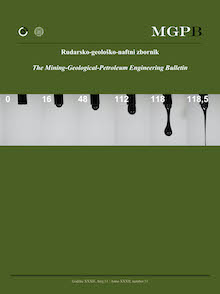Core Log and Cone Penetration Test Approach for Bearing Capacity Analysis of Quaternary Deposit and its Correlation to Facies Distribution in Southern Bali
DOI:
https://doi.org/10.17794/rgn.2020.4.1Keywords:
bearing capacity, sediment, CPTu, facies, southern BaliAbstract
Area development deals with optimal land use and the reduction of the risk of geological disasters. The coastal area of South Bali is prone to land settlement hazards. In order to mitigate the risk, it is important to understand the depositional environment of the area related to its bearing capacity and geological hazard risks. The aim of this research is to understand the subsurface depositional environment and quantifying its bearing capacity. Quantitative modeling was carried out to obtain the sediment-bearing capacity of the Pendungan area in Bali, Indonesia. The methods used in this research were the observation of borehole cores, the identification of the cone penetration test (CPTu) curves pattern, the sediment index property test, the soil strength laboratory, and bearing capacity analysis. Based on lithologic association, the CPTu curve pattern, and grain size analysis, there are three facies developing in the study area with different bearing capacity values. Generally, beach ridge sand has a higher bearing capacity (N-SPT value of 8 – 52) for shallow foundation than fluvial clay. Meanwhile, floodplain facies has the lowest bearing capacity (N-SPT value of 2 – 20).
Downloads
Published
How to Cite
Issue
Section
License
Copyright (c) 2020 authors and journal

This work is licensed under a Creative Commons Attribution 4.0 International License.
Creative Commons-BY
Authors who publish with this journal agree to the following terms:
In agreeing this form, you certify that:
- You read the ethical codex of the RGN zbornik available at journal web.
- You submitted work is your original work, and has not previously been published and does not include any form of plagiarism.
- You own copyright in the submitted work, and are therefore permitted to assign the licence to publish to RGN zbornik.
- Your submitted work contains no violation of any existing copyright or other third party right or any material of an obscene, libellous or otherwise unlawful nature.
- You have obtained permission for and acknowledged the source of any illustrations, diagrams or other material included in the work of which you are not the copyright owner.
- You have taken due care to ensure the accuracy of the work, and that, to the best of your knowledge, there are no false statements made within it.
- All co-authors of this submitted work are aware of, and in agreement with, the terms of this licence and that the submitted manuscript has been approved by these authors.
Publication licence
You retain copyright in your submitted work, according to journal license policy (CC-BY). By signing this form you agree that RGN zbornik may publish it under the publication licence. In summary the licence allows the following:
Anyone is free:
- To copy, distribute, display, and perform the work.
- To make derivative works.
Under the following conditions:
- The original author must always be given credit.
- The work may not be used for commercial purposes.
- If the work is altered, transformed, or built upon, the resulting work may only be distributed under a licence identical to this one.
Exceptions to the licence
In addition to publishing the work printed under the above licence, RGN zbornik will also enable the work to be visible online.
The journal editorial can change the licence rules anytime but it cannot retroactively restrict author(s) rights.


